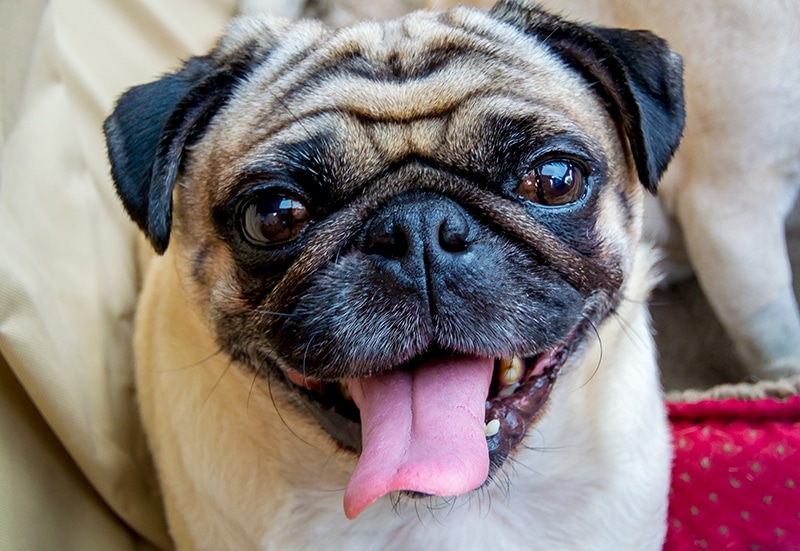Picking the best dog food for your Pug can be challenging (The Puggle is real!). As you know, your Puggie tends to be a greedy eater and overeat and quickly gain weight if her diet is unbalanced. Therefore, you have to make plenty of decisions, from considering Fido’s life stage and health requirements to ensure that she gets all the proper nutrients from the highest quality sources. All of this with the abundance of information might be overwhelming.
I used my 12 years of Veterinary experience and reviewed over 100 dog food products to find the best dog food for Pugs.
After considering the nutritional needs along with genetic health conditions that Pugs tend to have, I found that “Nutro Wholesome Essentials Small Breed” Adult is the best overall food for adult Pugs. In addition to meeting my dietary criteria for Pugs, it has the best combination of nutrients and quality sources.
But I understand that no two Pugs are alike, and your Pug might have a different life stage or have different needs. That’s why I prepared a shortlist of the best Pug foods that address the most common Pug needs.
In addition to picking the best products for your pooch, I outlined my process for choosing dog food. I want you to know what gets inside the furry stomach. The process is written in plain & simple English that will help you make wiser dietary decisions for your Pug.
I encourage you to read our review process and check out our in-depth reviews below so that you’ll be able to come up with your own dietary decisions.
Let’s get started.
Before You Pick The Best Food For Your Pug

There’s no such thing as one food that fits all Pugs. While we did our best in finding the best food for the majority of Pugs, you might prefer to pick a more specific formula.
That’s why we elaborate here our main considerations while reviewing the best dog foods for Pugs.
You can divide your research journey into 3 steps:
There’s no such thing as one food that fits all Pugs. While I did my best to find the best food for most Pugs, you might prefer to pick a more specific formula.
That’s why I elaborate here our main considerations while reviewing the best dog foods for Pugs.
You can divide your research journey into 3 steps:
- Picking the right food for your Pug’s life stage – Puppies, Adults and Senior Pugs are in different development stages. Their joints, bones, and muscles develop at a different pace. That’s why you’ll need to pick the proper nutrients in the correct quantity for your Pug’s life stage.
- Picking the right food to reduce common Pug health issues – Each dog breed has an increased risk of catching certain health conditions. These health conditions are genetic and Pugs are not indifferent. So make sure to pick the right ingredients to support common Pug health issues.
- Picking suitable nutrient sources – Sometimes, two dog foods might seem similar. Both could provide the same nutritional value. However, it’s essential to question how these nutrients were sourced. We want to avoid chemicals and low-quality nutrients that can introduce some side effects.
The rest of the guide will show you how to pick the right food for your Pug’s life stage, how diet helps with common Pug health issues, and what to look for on the label.
For your convenience, I (Dr. Libby Guise) shortlisted 14 dog foods. These foods were carefully selected and should satisfy your Pug’s needs. I also noted which food is best for certain life stages or particular health issues.
After going through the shortlist, you can find additional considerations that might be of interest to you and your fur-baby.
Finally, I answered the most popular questions that I’m being asked regarding Pugs’ nutrition and diet.
Please keep in mind, while I tried to do my best to find the best food for your Pug, it would be a good idea to understand how and why we made our decisions.
The recommendations in this review are not intended to replace the doctor-patient relationship. Always consult your veterinarian before making significant adjustments to your furbaby’s diet.
The Right Diet For All Life Stages
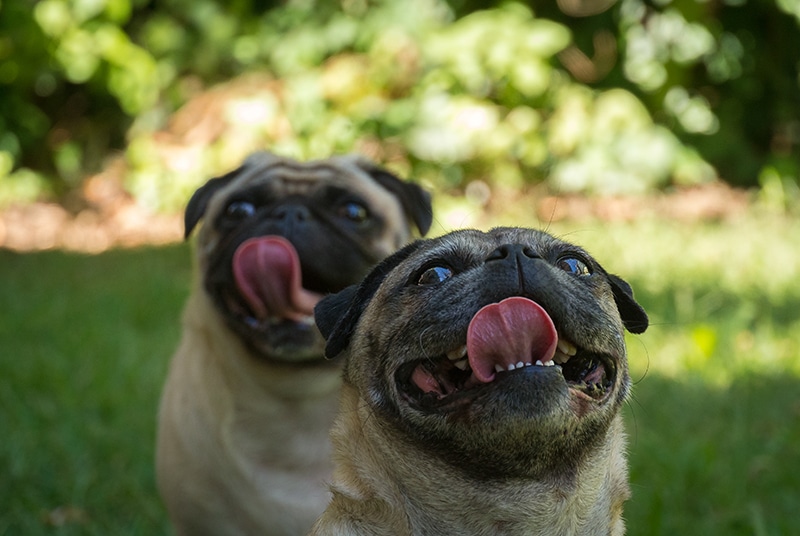
They’re absolutely adorable and often quite playful and energetic. But pugs have some unique challenges because of their flat faces and compact bodies. They love to eat and can quicklybecome obese.
Like many breeds today, Pugs can suffer from bone and joint disorders. In addition, because they’re a brachycephalic breed, they frequently suffer from breathing problems. Their skin folds also set them up for infections and other issues. And some pugs struggle with stomach issues and allergies.
When talking about the best food for pugs, start with quality ingredients:
- Feed a protein-rich diet (around 18% for adults and 30% for puppies) from lean poultry, fish, or meat. Avoid processed by-products and meat derivatives.
- Choose low-fat (about 5%) products with healthy sources of essential and omega fatty acids.
- Look for complex carbohydrates, including whole grains, sweet potatoes, and other vegetables, to provide fiber and energy.
- Select formulas that include fruits and vegetables to provide a balance of antioxidants, vitamins, and minerals for your pup’s overall health.
- Other ingredients that help to support your pug include
- Glucosamine and chondroitin for joint health
- Probiotics to support the gut
- DHA and taurine for the heart
Daily Calorie Requirements
Your pug’s daily energy needs will change at different stages of life. Puppies need more calories to fuel both activity and growth. As adults, the calorie requirements level out. The energy demand often decreases in the senior years when dogs become less active.
- Puppies: In general, a pug puppy needs about 50 calories per pound of body weight.
- Adults: Full-grown pugs require about 40 calories per pound of body weight.
- Seniors: Around 6-7 years, pugs enter their senior years. Their activity and metabolism levels slow down. As a result, their energy requirements will be about 20% lower, or around 32 calories per pound.
Feeding Quantity & Frequency
The amount of food you feed your pug will change with age, and so will the frequency of meals. Follow package guidelines based on your pal’s age and weight to determine how much food to give. If your furbaby is gaining weight, cut back a small amount, and if he’s losing weight, up the amount slightly.
Puppies burn energy much more quickly and will need to refuel more often than adults and seniors.
- Weaned puppies under 3 months should have at least 4 meals a day
- From 3-6 months, feed your pooch 3 meals a day
- From 6-12 months, and above can have 2 meals a day
The Appropriate Nutrition For Common Pug Health Issues
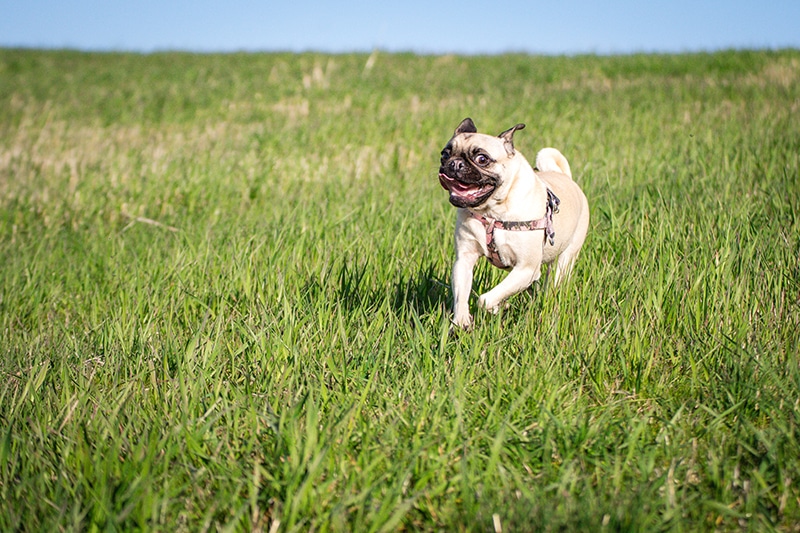
Some health conditions are more popular among Pugs than other dog breeds. Each breed inherits some genes that can be associated with certain health issues.
It doesn’t mean that Fido is going to develop these conditions, it just means that Pugs have a higher chance as compared to other breeds.
However, it’s possible to reduce the risk by proactively feeding Pug with the right nutrients. Here we list the most common Pugs health issues and how certain nutrients can reduce risk.
A quick reminder: if you think your special pal suffers from any of these conditions, schedule an exam with your veterinarian to confirm your suspicions. Even with healthy dogs, these dietary recommendations may help prevent future problems. Always check with Fido’s doctor before making changes in his diet.
Portosystemic Shunts
The Pug has a high risk for portosystemic shunts. With this condition, there’s an abnormal connection between blood that’s normally carried to the liver and the systemic circulation. Normally, blood with toxins and waste materials from the body organs travels to the liver for filtering. When animals are born with a shunt, the blood bypasses the liver and heads back to the rest of the body.
If your pup has a portosystemic shunt, it may have stunted growth, be lethargic, have a wobbly gait, experience seizures, become aggressive, or demonstrate other symptoms. While surgical correction can help in some cases, medication and special diets can also help stabilize affected dogs. The key is to feed a low-protein diet with quality, digestible ingredients.
Eye Problems
Those adorable bug eyes can predispose pugs to eye conditions including:
- Corneal ulcers
- Cherry eye, usually due to an irritated tear duct
- Eye injuries
- Entropion or an eyelid that rolls inwards and irritates the cornea
If your pooch has red or watery eyes or seems to be rubbing his face, talk to your veterinarian. But regardless of the underlying condition, you can provide nutritional support for good eye health. Offer fresh, high-quality ingredients from various sources including:
- Orange vegetables that are rich in beta-carotene, such as pumpkin and carrots
- Blueberries and other antioxidant-rich fruits
- Dark green vegetables like broccoli and kale for phytonutrients
- Oily fish such as salmon and sardines to provide omega fatty acids
Avoid foods that have fillers, simple carbohydrates, cereals, and highly processed ingredients. These materials can trigger food sensitivities and allergic reactions that cause dull, runny, crusty eyes.
Bone and Joint Problems
Due to their specialized breeding over the years, pugs are genetically prone to developing joint disorders including:
- Hip dysplasia – the hip socket is malformed causing excessive movement in the joint. Over time, the friction damages the cartilage and causes degenerative arthritis.
- Luxating Patellas – the knee joint is too shallow, and the kneecap pops out of place, usually during exercise. The result is intermittent lameness or hobbling. Over time, there can be damage to the joint cartilage.
- Legg-Calve-Perthes Disease – inadequate blood flow to the femur causes the femoral head to die and become necrotic. Lameness usually shows up in puppies. The best solution for this condition is the surgical removal of the ball of the femur.
With any of these conditions, it’s important to support muscle mass, bone strength, and joint health. Provide high-protein diets using quality, lean muscle ingredients for essential amino acids. The formula should have a proper balance of calcium and phosphorus to support the bones. Products that supply glucosamine and chondroitin promote healthy joint function.
In addition to these nutrients, you want food that’s low fat and has moderate carbohydrates from digestible ingredients to prevent unwanted weight gain. Look for healthy fat sources that provide omega fatty acids to help manage any inflammation.
Skin Disorders
Pugs have a characteristic, wrinkly skin that makes them susceptible to bacterial or fungal infections. Additionally, this breed can suffer from hair loss or alopecia. In addition to properly caring for your pal’s skin folds, choose diets that support skin health. Look for formulas that are rich in antioxidants, vitamin E, and omega fatty acids.
Seizures and Epilepsy
Pugs can suffer from epilepsy and seizures, which are sudden surges of brain activity. While there’s no cure, the condition can be managed with medications and diet. If your furbaby has signs like muscle tremors, twitching, or loss of bladder or bowel control contact your veterinarian for a work-up.
Proper nutrition that can help support your furbaby includes:
- Healthy, quality fats including sources of omega 3 and 6 fatty acids. These ingredients help to manage inflammation and may help to decrease the severity and frequency of seizures.
- Because allergies can trigger seizures, avoid common allergens such as soy, dairy products, and gluten-containing materials.
- Provide protein-rich products with quality ingredients and digestible complex carbohydrates to provide adequate energy.
Pug Dog Encephalitis
An inherited, fatal disease, Pug Dog Encephalitis(PDE) usually affects young to middle-aged pugs. This condition involves inflammation and death of brain tissue. Symptoms include:
- Circling
- Seizures
- Head pressing
- Disorientation
- Behavioral changes
- Limb weakness and stumbling
If you notice any of these symptoms, contact your veterinarian. Unfortunately, there’s no cure for PDE, but with an early diagnosis, medication and diet may help improve your pup’s quality of life for the duration. Provide your pal with plenty of water. Focus on a diet consisting of quality ingredients including healthy sources of omega fatty acids to manage inflammation. Antioxidant-rich ingredients such as garden vegetables also support cellular health.
Arachnoid Cysts
Some brachycephalic breeds, including the Pug, have a congenital condition known as arachnoid cysts. Fluid-filled sacs may develop in the brain or spinal cord. Often, there are no symptoms, but some brain cysts can cause seizures. The best treatment is surgical drainage of the sacs, but that can be complicated when the lesion is in the brain.
In addition to surgical intervention, you may be able to provide supportive care through medications and diet. As with PDE, look for products that include omega fatty acids for inflammation and antioxidants for cellular repair and health.
Stomach Issues
Pugs can be prone to a sensitive stomach and may have diarrhea or vomiting. If your pup has food sensitivities, feed a quality diet with digestible proteins from real meat sources. Choose a low-fat diet that includes omega fatty acids to help manage inflammation. The product also should include fiber from fruits and vegetables along with probiotic cultures to soothe the gut and promote digestive health.
Breathing Issues
The brachiocephalic structure looks adorable, but it creates a range of problems for pugs known as Brachycephalic Airway Obstruction Syndrome (BAOS). This condition features several issues, including:
- Stenotic nares – a birth defect involving the soft tissue of the narrow nasal cavity. The tissues collapse when your pup inhales making breathing very difficult.
- Reverse sneezing – fluid and debris get caught in the short nasal passage and need to be expelled.
- Elongated soft palate – the palate partially overlaps the airway which complicates breathing and causes coughing, gagging, and sometimes choking or vomiting.
- Collapsing trachea – a birth defect in which the cartilaginous rings of the trachea are weak and can collapse.
- Pharyngeal turbinates – normally in the nasal cavity, in pugs these bones are at the back of the upper throat.
These breathing problems are due to congenital defects and can not be prevented. However, a diet that focuses on quality nutrition and weight control can help manage the symptoms. Obesity puts additional stress on the airway, so feed a high-protein, low-fat, low-carb diet that’s rich in omega fatty acids and antioxidants. Because allergies are counterproductive for pups with BAOS, avoid common allergens such as gluten, wheat, and corn.
Allergies
When it comes to pug allergies, the most common cause is food, but environmental allergens may also cause issues. Signs of an allergy problem include diarrhea, itchy skin, upset stomach, wheezing, and difficulty breathing. If you think your pooch has allergies, contact your veterinarian.
When dealing with pug allergies, offer a diet with quality whole foods and no artificial ingredients or additives. Avoid known or common allergens such as corn, gluten, or soy. Look for products that include:
- antioxidant-rich fruits and vegetables to promote cellular health and immunity
- Omega fatty acids and vitamin E for skin and coat health
- Probiotics to soothe the gut
Ensuring High-Quality Nutrients
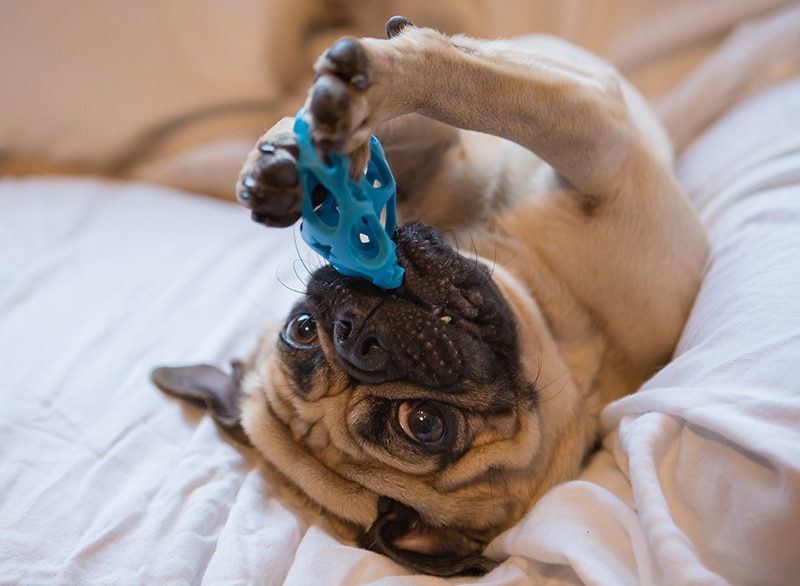
Now that you have information about the basic nutritional needs of Pugs and how to adjust their diets to prevent some common health conditions, we need to ensure that the nutrient sources are best of class.
- Kibble Size – Even though Pugs are the largest of the toy breeds, they still require small-sized kibble to fit their short muzzle and small mouths. Choose products that are designed for toy and small breeds.
- Age Appropriate – Remember that growing pugs need more energy and protein to fuel both growth and activity. Puppy food is formulated to provide the nutrients your furbaby needs for proper development. That’s why it’s important to feed products that are appropriate for your pal’s age and stage of life.
- Starts With Quality Lean Protein – As descendants of wolves, all dogs need a protein-rich diet that comes from quality ingredients. Look for products that have lean animal-based proteins such as chicken, turkey, or fish as the first ingredient on the label.
- Has Low to Moderate Fat – While playful and energetic, pugs don’t have the same calorie needs as sporting and working dogs. Pick food with a low to moderate fat content from healthy sources. The formula should include omega fatty acids to support the coat and skin.
- Made Using Digestible Materials – With the Pug’s sensitivity and tendency toward allergies, you want a product that’s free of fillers and has ingredients that are easy to digest. Choose products with digestible proteins, whole grains, garden vegetables, and fruits. These natural ingredients help provide fiber to support the gut and keep stools firmer.
- Ingredients to Avoid – Always check the label to ensure your pup’s food has wholesome ingredients. Avoid materials such as meat and animal derivatives and poultry by-products which may contain hooves, feathers, lungs, and other body parts. You should also stay away from foods with corn, soy, or cereal fillers that could trigger allergies or food sensitivities.
- Free From Chemical Preservatives – Chemical preservatives can be hard on your pug’s system, and some are suspected carcinogens. Avoid products with BHA, BHT, propylene glycol, Ethoxyquin, and nitrates/nitrites. Choose food that uses natural preservatives such as tocopherols like vitamin C or herbs such as rosemary.
- Focuses on Limited Ingredients – If your furbaby suffers from food allergies or a sensitive stomach, products with approximately six to eight whole food ingredients may be helpful. Properly formulated diets don’t need a long list of materials to meet your pal’s nutritional needs. And having fewer ingredients makes it easier to identify and eliminate trigger foods.
- Enriched With Useful Supplements – There are several supplements that can help support your pug’s health. Depending on your pal’s age and specific needs, look for:
- Controlled levels of calcium and phosphorus for proper bone growth
- Glucosamine and chondroitin to support joint mobility
- Omega fatty acids for skin, coat, and brain health
- Antioxidants to support cellular function and repair
- Probiotics to soothe the gut and support digestion
- Meets AAFCO nutritional requirements for a complete and balanced food – The AAFCO is a team of scientists that includes veterinarians and nutritionists. This group conducts studies to determine nutritional requirements for pet foods and animal feeds. Look for a statement that indicates the product complies with AAFCO requirements.
- Contains No Artificial Ingredients – Some artificial flavors and coloring can be irritating to the gut or may cause cancer. Pick products that use only natural ingredients to prevent food sensitivities and other health problems.
- Made in Trusted Countries – Some nations including Australia, Canada, France, and the United States follow good manufacturing practices when they produce dog food. Look for the country of origin to ensure that your pal’s food is manufactured safely.
Our 2026 Review For 14 Dog Foods For Pugs
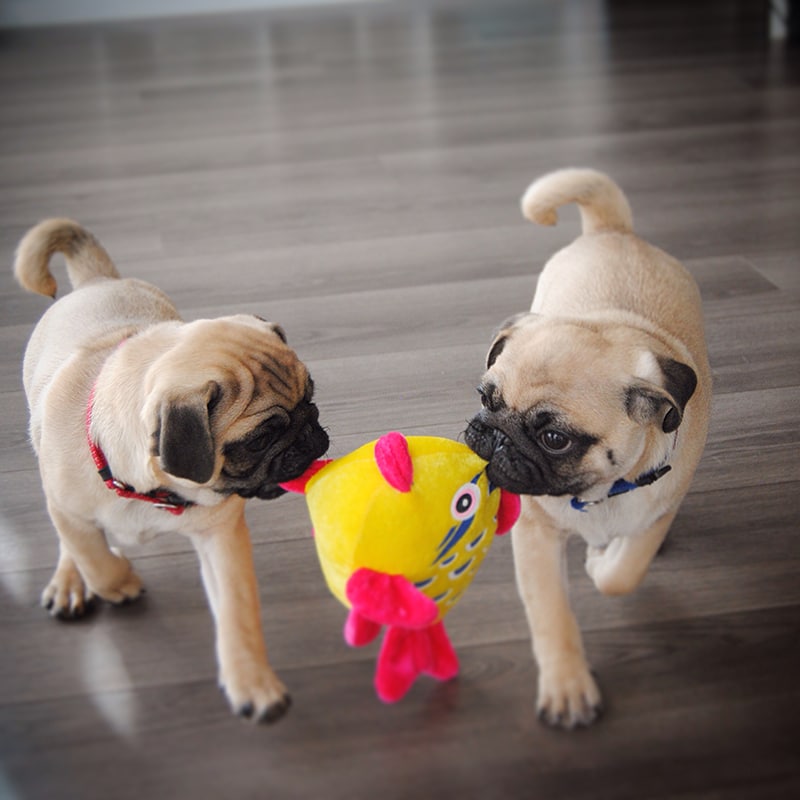
We reviewed over 100 products by following the process presented above and classified the best of them based on everyday Pug needs.
We considered the life stage, common Pug health issues for each pick and ensured it has the best nutrient sources.
Nutro Wholesome Essentials Small Breed
- First 5 ingredients: Chicken, Chicken Meal, Whole Grain Barley, Split Peas, Brewers Rice
- Key feature: high protein, moderate fat
- Guaranteed Analysis: 24% Crude Protein, 16% Crude Fat,3.5% Crude Fiber, 10% Moisture
- Caloric Content: 352 kcal/cup
- Type of Product: Natural Dry Dog Food
- Life Stage: Small Breed Adult
- Best for: Overall Pick
- AAFCO Statement: formulated to meet the nutritional level established by AAFCO Dog food nutrient profile for maintenance
This product starts with animal-based protein for the first two ingredients to provide your pup with essential amino acids for healthy muscles. The fat content includes healthy sources of omega fatty acids to promote skin and coat health.
With whole grains for digestible carbohydrates, the formula provides the energy your pup needs for daily activity. Fruits and garden vegetables are rich sources of antioxidants and phytonutrients for cellular health. There’s a balanced blend of essential vitamins and minerals in the formula.
The product includes natural sources of glucosamine and chondroitin to support joint mobility. There are no artificial ingredients or fillers in this kibble.
Owners say their dogs like the flavor of this food, and they have healthy skin and coats when they eat it.
Wellness Small Breed Complete Health Puppy Recipe
- First 5 ingredients: Deboned Turkey, Chicken Meal, Oatmeal, Salmon Meal, Barley
- Key feature: small breed, high-protein
- Guaranteed Analysis: 28% Crude Protein, 19% Crude Fat, 4.25% Crude Fiber, 10% Moisture
- Caloric Content: 489kcal/cup
- Type of Product: small kibble, all-natural
- Life Stage: Puppy
- Best for: Pug Puppies
- AAFCO Statement: formulated to meet the nutritional level established by AAFCO Dog food nutrient profile for maintenance
This product features wholesome protein as the first two ingredients. Turkey and chicken meal provide essential amino acids for healthy muscles along with a natural source of glucosamine and chondroitin to promote joint mobility.
Essential Fatty Acids, including omega fatty acids from a salmon meal, provide energy and nutrients for the brain, coat, and skin health. The formula includes whole grains for digestible carbohydrates.
With garden vegetables and fruits, this product has a balanced blend of antioxidants, minerals, and vitamins for whole-body health. Probiotic microorganisms are also in the formula to promote digestive health.
Owners say the small kibble is easy to chew, their pups like the food, and it helps puppies grow.
Blue Buffalo Life Protection Adult Small Breed
- First 5 ingredients: Deboned Chicken, Chicken Meal, Brown Rice, Oatmeal, Barley, Menhaden Fish Meal
- Key feature: Moderate protein, moderate fat
- Guaranteed Analysis: 26% Crude Protein,15% Crude Fat,4% Crude Fiber, 10% Moisture
- Caloric Content: 397 kcal/cup
- Type of Product: Dry dog food
- Life Stage: Adult
- Best for: Senior Pugs
- AAFCO Statement: formulated to meet the nutritional level established by AAFCO Dog food nutrient profile for maintenance
This kibble offers essential amino acids for your pug’s muscles starting with animal protein as the first two ingredients. The whole grain sources provide the energy he needs to fuel an active adult lifestyle.
With antioxidant-rich vegetables and fruits, the formula has a balanced blend of essential nutrients for overall health. The moderate fat content includes healthy sources of omega fatty acids for the brain, coat, and skin health.
This product includes prebiotic fiber and probiotics for gut health—natural sources of glucosamine and chondroitin. Promote joint mobility.
Customers share that this food offers great nutritional support for seniors, and the kibble is a perfect size for smaller mouths.
Eagle Pack Original Adult Lamb Meal & Brown Rice Formula
- First 5 ingredients: Lamb Meal, Oatmeal, Ground Brown Rice, Dehulled Barley, Chicken Fat
- Key feature: high protein, moderate fat
- Guaranteed Analysis: 23% Crude Protein,12% Crude Fat,4% Crude Fiber, 10% Moisture
- Caloric Content: 337 kcal/cup
- Type of Product: Natural dry dog food
- Life Stage: Adult
- Best for: Budget
- AAFCO Statement: formulated to meet the nutritional needs established by the AAFCO Dog Food Nutrient Profiles for Maintenance
Starting with digestible protein as the first ingredient, this product provides essential amino acids for your pup’s muscles. The moderate fat content provides adequate energy for an active pug and includes omega fatty acids.
Healthy whole grains provide a source of digestible fiber and carbohydrates. The formula has a blend of essential nutrients including a controlled balance of calcium and phosphorus for strong bones. Natural sources of glucosamine and chondroitin promote joint health.
This formula is supplemented with at least 70 million CFU/lb of probiotic microorganisms for gut health. There are no artificial ingredients or chemical preservatives in the product.
Customers say their dogs love the food, and the ingredients are easy on the tummy.
Wellness CORE Grain-Free Small Breed Turkey & Chicken Recipe
- First 5 ingredients: deboned turkey, turkey meal, chicken meal, lentils, peas
- Key feature: high protein, moderate fat
- Guaranteed Analysis: 36% Crude Protein,16% Crude Fat,5% Crude Fiber, 10% Moisture
- Caloric Content: 412 kcal/cup
- Type of Product: Grain-free, protein-rich dry dog food
- Life Stage: Adult
- Best for: Active Lifestyle
- AAFCO Statement: formulated to meet the nutritional level established by AAFCO Dog food nutrient profile for maintenance
Packed with quality protein, this grain-free food provides the essential amino acids for your active pug’s muscles. With a moderate fat content from healthy sources, your pooch will have the fuel to keep moving.
The formula includes a blend of wholesome fruits and vegetables to supply antioxidants, minerals, and vitamins for whole-body health. Chicken and Turkey meals provide natural sources of glucosamine and chondroitin for joint and cartilage health.
In addition to digestible ingredients, this food has probiotics to soothe the gut and promote digestive health. There are no artificial ingredients or fillers in the formula.
Customers say their dogs love the food, and the small, triangular shape is perfect for little mouths and teeth.
Castor & Pollux ORGANIX Organic Small Breed Recipe
- First 5 ingredients: Organic Chicken, Organic Chicken Meal, Organic Sweet Potatoes, Organic Potatoes, Organic Peas
- Key feature: high protein, moderate fat
- Guaranteed Analysis: 26% Crude Protein,15% Crude Fat,3.5% Crude Fiber, 11% Moisture
- Caloric Content: 387 kcal/cup
- Type of Product: Organic dry dog food
- Life Stage: Adult
- Best for: Adult Pugs
- AAFCO Statement: formulated to meet the nutritional level established by AAFCO Dog food nutrient profile for maintenance
This formula offers a protein-rich diet for lean muscle mass starting with organic chicken and chicken meal as the top two ingredients. The moderate fat content comes from healthy sources and includes omega fatty acids for brain, skin, and coat health.
A rich blend of superfoods, including garden vegetables and blueberries, provide antioxidants and essential nutrients for whole-body health. Taurine is included in the formula to support the heart.
With digestible ingredients and prebiotic fiber, this food is formulated to be easy on the stomach Probiotics help soothe the gut and promote healthy digestion.
Customers who tried this food say their dogs love the flavor, and it helps eliminate smelly gas.
Holistic Select Adult Health Lamb Meal Recipe Dry Dog Food
- First 5 ingredients: Lamb Meal, Oatmeal, Peas, Rice, Chicken Fat
- Key feature: High-protein, moderate fat
- Guaranteed Analysis: 23% Crude Protein,15% Crude Fat,4.5% Crude Fiber, 10% Moisture
- Caloric Content: 454 kcal/cup
- Type of Product: Natural, single-protein food
- Life Stage: Adult
- Best for: Heart Health
- AAFCO Statement: formulated to meet the nutritional levels established by the AAFCO Dog Food Nutrient Profiles for maintenance
Featuring lamb meal as the first ingredient, this protein-rich formula provides the building blocks for strong muscles. Natural sources of omega 3 and 6 fatty acids support the brain, skin, and coat.
The product includes digestible whole grains, garden vegetables, and antioxidant-rich fruits to provide a balanced nutrient blend. Prebiotic fiber and probiotics soothe and support the gut. All these nutrients help to promote heart health.
Digestive enzymes from papaya and other ingredients help to boost the metabolism and prevent unwanted weight gain. The formula includes supplementation with Taurine to support heart health.
Owners report that this food helps firm up the stool and ease allergy symptoms.
Natural Balance Fat Dogs Chicken & Salmon Formula Low-Calorie
- First 5 ingredients: Chicken Meal, Salmon Meal, Chickpeas, Dried Peas, Oat Groats
- Key feature: Low-Calorie Food
- Guaranteed Analysis: 26% Crude Protein,7.5% Crude Fat,10.5% Crude Fiber, 10% Moisture
- Caloric Content: 315cal/cup
- Type of Product: Low-Calorie adult dry food
- Life Stage: Adult
- Best for: Weight Loss
- AAFCO Statement: formulated to meet the nutritional needs established by the AAFCO Dog Food Nutrient Profiles for maintenance
Starting with digestible lean protein ingredients, this product offers healthy sources of amino acids to support lean muscle mass. The low-fat formula relies on healthy ingredients to provide essential fatty acids and omega fatty acids.
In addition to providing protein, the chicken meal is a natural source of glucosamine and chondroitin for joint health and mobility. In addition, L-carnitine is included in the formula to boost the metabolism and help keep off unwanted pounds.
Whole food ingredients from garden vegetables and fruits add antioxidants and essential nutrients. There are no artificial ingredients in the formula.
Customers share that their dogs like the flavor and this formula helps overweight pups lose he extra pounds.
Rachael Ray Nutrish Just 6 Limited Ingredient Recipe
- First 5 ingredients: Lamb Meal, Brown Rice, Ground Rice, Dried Plain Beet Pulp, Chicken Fat
- Key feature: Limited ingredient
- Guaranteed Analysis: 20% Crude Protein, 14% Crude Fat, 4% Crude Fiber, 10% Moisture
- Caloric Content: 321 kcal/cup
- Type of Product: Dry Dog Food
- Life Stage: Adult
- Best for: Sensitive Stomach
- AAFCO Statement: formulated to meet the nutritional levels established by the AAFCO Dog Food Nutrient Profiles for Maintenance
Starting a digestible protein source, this formula is designed to be easy on digestion. Rice provides soothing fiber and carbohydrates for your pal’s energy needs.
There are six ingredients in this product to help you avoid trigger foods for your pup. There are no artificial materials or common allergens such as corn, wheat, or soy.
Omega 3 and 6 fatty acids promote healthy skin and coat and help to manage inflammation. The formula includes a balanced blend of essential nutrients.
Owners of pups with food allergies and sensitive stomachs say this food is easy on the gut and helps to soothe itchy skin.
AvoDerm Natural Lamb Meal & Brown Rice Formula Adult Dry Dog Food
- First 5 ingredients: Lamb Meal, Ground Brown Rice, Ground White Rice, Oatmeal, Chicken Fat
- Key feature: high protein, moderate fat
- Guaranteed Analysis: 21% Crude Protein,11% Crude Fat,5% Crude Fiber, 10% Moisture
- Caloric Content: 360 kcal/cup
- Type of Product: Dry Dog Food
- Life Stage: Adult
- Best for: Skin Allergies
- AAFCO Statement: formulated to meet the nutritional needs established by the AAFCO Dog Food Nutrient Profiles for Maintenance
This product starts with a Lamp meal to provide a wholesome source of essential amino acids for your pal’s muscles. Next, avocado and other healthy sources of fat offer omega fatty acids to support the skin and coat and help reduce inflammation.
With digestible grains from rice and oatmeal, this formula is designed to be gentle on the gut. There are no common allergens such as corn, soy, or wheat included in the ingredients.
Prebiotic fiber and probiotics support gut health. In addition, natural sources of digestive enzymes help to promote overall health and boost the metabolism. There are no artificial ingredients in this product.
Customers report that feeding this product helps to clear up skin allergies in their dogs.
Purina Pro Plan Adult Sensitive Skin & Stomach
- First 5 ingredients: Salmon, Barley, Rice, OatMeal, Canola Meal
- Key feature: high protein, moderate fat
- Guaranteed Analysis: 26% Crude Protein, 26% Crude Fat, 4% Crude Fiber, 12% Moisture
- Caloric Content: 467kcal/cup
- Type of Product: Sensitive Stomach and Skin
- Life Stage: Adult
- Best for: Allergies
- AAFCO statement: formulated to meet the nutritional level established by the AAFCO Dog food nutrient profile for maintenance
Formulated to support a healthy skin, coat, and digestion, this food starts with Salmon as the first ingredient. The wholesome protein also provides a rich source of omega fatty acids to help manage inflammation.
Healthy whole grains that are low in gluten or gluten-free provide digestible carbohydrates with low allergen risk. Prebiotic fiber and probiotic cultures soothe the gut and promote healthy digestion.
The all-natural formula includes a balanced blend of essential vitamins and minerals for whole body health.
Owners of pooches with skin and food allergies say this food helps clear up irritated skin and runny stools.
Merrick Lil’ Plates Grain-Free Real Beef & Sweet Potato Dry Dog Food
- First 5 ingredients:Deboned Beef, Lamb Meal, Sweet Potatoes, Peas, Potatoes
- Key feature: grain-free
- Guaranteed Analysis: 38% Crude Protein,15% Crude Fat,3.5% Crude Fiber, 11% Moisture
- Caloric Content: 402cal/cup
- Type of Product: Dry small breed adult food
- Life Stage: Adult
- Best for: Joint Health
- AAFCO Statement: formulated to meet the nutritional needs established by the AAFCO Dog Food Nutrient Profiles for maintenance
Quality protein from three sources in this product provides a blend of essential amino acids to help your pooch maintain lean muscle mass. The glucosamine and chondroitin from lamb meal supports cartilage health and joint mobility.
With a moderate fat content, this formula includes omega fatty acids to promote skin and coat health and to manage inflammation. A balanced blend of minerals and vitamins supports whole body health.
Digestible vegetables and fruits provide a rich source of antioxidants for cellular health. The product includes probiotics to soothe the gut and support digestion.
Owners say their pups like the flavor of this product, and the kibble is a perfect size for little mouths.
Nature’s Recipe Small Breed Grain-Free
- First 5 ingredients: Chicken, Chicken Meal, Garbanzo Beans, Peas, Pea Starch
- Key feature: grain free
- Guaranteed Analysis: 25% Crude Protein,15% Crude Fat, 4% Crude Fiber, 10% Moisture
- Caloric Content: 352 kcal/cup
- Type of Product: Grain-Free Dry Dog Food
- Life Stage: Adult
- Best for: Grain-free
- AAFCO Statement: formulated to meet the nutritional needs established by the AAFCO Dog Food Nutrient Profiles for Maintenance
The first two ingredients in this food are lean protein to provide essential building blocks for your pup’s muscles. The moderate fat content features healthy sources of omega and essential fatty acids.
Wholesome garden vegetables including pumpkins and potatoes provide digestible carbohydrates for energy. Taurine is included in the formula to support heart health.
There are natural sources of glucosamine and chondroitin in the formula that help to support joint mobility. This product contains no artificial ingredients.
Pug owners say their pups love the flavor of this food, and it keeps them healthy.
Blue Buffalo Wilderness Small Breed Grain-Free Canned Dog Food
- First 5 ingredients: Turkey, Chicken, Chicken Broth, Turkey Liver, Potatoes
- Key feature: Ground food
- Guaranteed Analysis: 10% Crude Protein,8% Crude Fat, 1.5% Crude Fiber, 78% Moisture
- Caloric Content: 216 kcal/can
- Type of Product: Wet Small Breed Dog Food
- Life Stage: Adult
- Best for: Canned Food
- AAFCO Statement: formulated to meet the nutritional needs established by the AAFCO Dog Food Nutrient Profiles for Maintenance
The top two ingredients in this ground food are turkey and chicken which provide healthy lean proteins to support your pup’s muscles. The moderate fat content offers energy and essential amino acids.
Glucosamine is included in the formula to support joint mobility and cartilage health. The product has a balanced blend of essential vitamins and minerals.
There are no artificial ingredients, by-products, or fillers in this food.
Owners say this food works great as a topper to encourage picky eaters to eat their kibble. Pups love the flavor.
Foods A Pug Should Not Eat
Pugs tend to be obsessed with food, and that makes it extra tempting to share table tidbits. But is it safe? While some foods are ok to give to your pup in small quantities, some are downright dangerous. You should never feed your pug:
- Alcohol, beer, or hops
- Avocado, particularly in large quantities
- Chocolate
- Caffeine from tea, coffee, or other sources
- Cooked bones
- Chives, onion, and garlic
- Grapes and raisins
- Macadamia nuts
- Raw eggs or raw fish
- Salty foods
- Yeast dough
- Xylitol which is often found in candy, gum, toothpaste, and some peanut butter
Is Grain-Free a Good Option for Pugs
Several years ago, the FDA cautioned pet owners that grain-free dog foods might be linked to developing a heart condition known as dilated cardiomyopathy (DCM). They noticed an increased number of cases in pups not normally known for this disease that had been on a grain-free diet.
After further study, a report in 2018 suggested that not all grain-free products were problematic, but those known as BEG diets might be the culprits. BEG stands for the boutique (a specialty brand), exotic meats (for example, ostrich, alligator, kangaroo, bison, and venison), and grain-free. In addition to these factors, many of the foods included potatoes, peas, and/or legumes in the top five ingredients.
As of July 2019, there were 524 reports of DCM that were potentially linked to grain-free diets. However, only two cases involved Pugs. Indeed, we need to monitor this potential link and study it further. However, the incidence of the disease is extremely low compared to an estimated US population of over 77 million dogs.
Currently, there is no dog food recalls linked to DCM in dogs. However, many veterinarians recommend providing your pooch with a balanced diet that includes wholesome whole grains for dogs prone to heart disease. Some grains such as oatmeal and quinoa are gluten-free or low in gluten. If your pooch requires a grain-free diet, look for products that have traditional protein sources such as chicken, fish, or beef.
Frequently Asked Questions
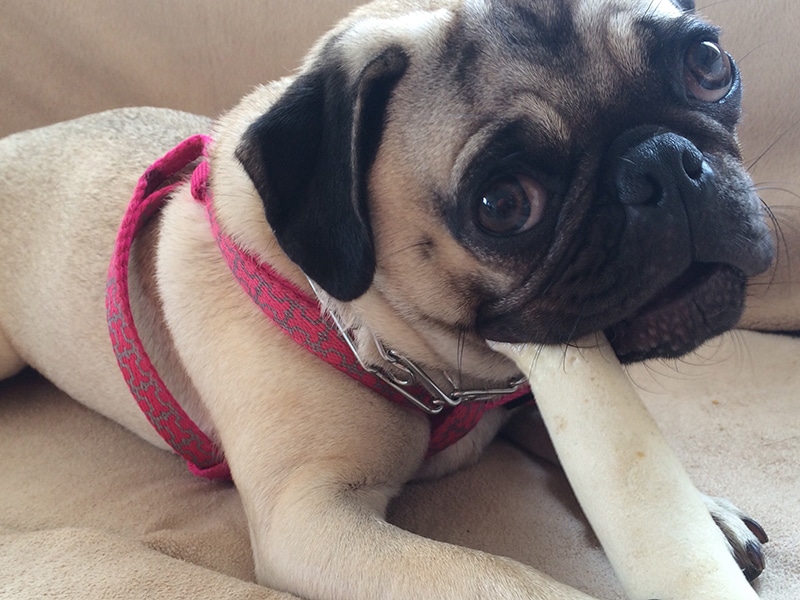
How do I change my Pug’s diet?
When it’s time to change your pal’s diet from puppy to adult food or to a different brand of food, do it gradually. We recommend slowly blending in the new food as follows:
- Days 1 and 2 – feed 25% new and 75% old formula
- Days 3 and 4 – feed a 50/50 blend
- Days 5 and 6 – feed 75% new and 25% old formula
- Day 7 – feed all new food
Do Pugs need special dog food?
Pugs do not require a pug-specific brand, but you should select food designed for small or toy breeds that has the proper balance of high protein, low to moderate fat, and controlled carbs.
What do I do if my pug is not eating?
Pugs may refuse to eat for a number of reasons. If your pal will not touch his food for more than a few meals(24 hours), or if he has:
- Diarrhea and vomiting for more than 1-2 days
- Acts panicked or painful
- Has blood in his vomit or stool
- Drools excessively
- Is suddenly lethargic
Contact your veterinarian immediately to schedule a visit. There could be a serious physical condition such as an intestinal blockage. Other reasons a pug may stop eating include stress, change of schedule or environment, change of activity levels, or dislike of the type of food you’re offering.
Do Pugs have a sensitive stomach?
Yes, pugs are known for problems with a sensitive stomach. Choose foods with digestible, wholesome materials and probiotics.
What Foods Are Pugs Allergic To?
Some of the most common allergens for pugs include beef, corn, dairy, soy, and wheat.
How do I know if my pug is overweight?
The pug’s shape can make it more difficult to tell if your pup is overweight at first glance. However, you should still be able to see a small waist indent when looking at your furbaby from above. When gently palpating over the ribs, you should be able to feel the bones through a thin fat layer.
How can I get my pug dog to lose weight?
If your pug is getting a little too pudgy, it may be time for a diet. Some things you can do to foster weight loss include:
- Exercising with your pooch – take extra walks or make your outings longer
- Plan visits to the dog park or puppy play dates
- Feed a lower carb diet or try making homemade food
- Cut back on treats and table scraps
Why is my pug always hungry?
Dating back to their wolf ancestors, dogs tend to be opportunistic eaters. If your pug always seems hungry, it may be that he has learned to beg because you offer table scraps after dinner. However, when your pooch suddenly develops a voracious appetite, there may be an underlying health issue. Contact your veterinarian if you have any concerns about your pal’s eating habits.
When should I stop feeding my Pug puppy food?
Pugs are considered to be adults around one year of age. You can start transitioning to adult food between 11 and 12 months.
Does my Pug need a puppy specific diet?
Pug puppies should be fed a diet formulated for small or toy breed puppies, but they don’t require a pug specific brand.
When is a Pug considered a senior?
Pugs are considered seniors around 6-7 years.
My Pug is a picky eater, is it ok to free feed him?
With their propensity for obesity, we don’t advise free feeding pug dogs. If you have a picky eater, you may try mixing a small quantity of wet food with the kibble or adding some low sodium broth to make it more appealing.
How long can a Pug go without eating?
Most dogs can go without eating for up to 5-7 days. However, if your pooch suddenly stops eating and refuses food for more than 1-2 days, you should contact your veterinarian.
Is milk good for Pugs?
Adult dogs lack the enzyme to digest milk sugars. Offering milk can cause digestive upset and diarrhea.
What human food can a Pug eat?
Pugs can eat many foods that humans eat including:
- lean meat, poultry and fish
- Garden vegetables including carrots, potatoes, and pumpkin
- Fruits including berries, bananas, melon, and apples without the seeds
Can Chicken Cause Harm to Pugs?
In most cases lean, deboned chicken is a wholesome protein option for pugs. However, if your furbaby is allergic to this poultry, you should avoid feeding it to him.
What is the worst food for a Pug?
There are several foods that are toxic for pugs. Some of the most poisonous materials include foods with xylitol or dark chocolate. Refer to our section above about which foods a pug should not eat for other items to avoid.
Dry vs Wet Food – Which is better for your Pug?
If you’re wondering whether to feed your pug dry or wet food, we recommend kibble.
While it’s true that both varieties can be equally nutritious, with their small mouth and tendency for crowded teeth, pugs usually do better with a dry product. The crunchy kibble helps to clean plaque and debris from the teeth, and this promotes dental health.
Of course, if your pal is missing some teeth or has another reason that he can’t handle hard kibble, you can try mixing in some canned product. Another way to make eating easier is to moisten the food with a small amount of low-sodium beef or chicken broth.
The Final Woof

Pugs need a protein-rich diet that’s low to moderate in fat to fuel their playful personality.
These pups can struggle with a sensitive stomach and allergies. They need quality ingredients from digestible whole foods. Sources of omega fatty acids and antioxidants help to manage inflammation and promote cellular repair.
Because they’re prone to obesity and joint problems, pugs should have a controlled level of carbohydrates from whole grains, fruits, and vegetables.
We recommend Nutro Wholesome Essentials Small Breed Adult as the best food for pugs with all these details in mind.

